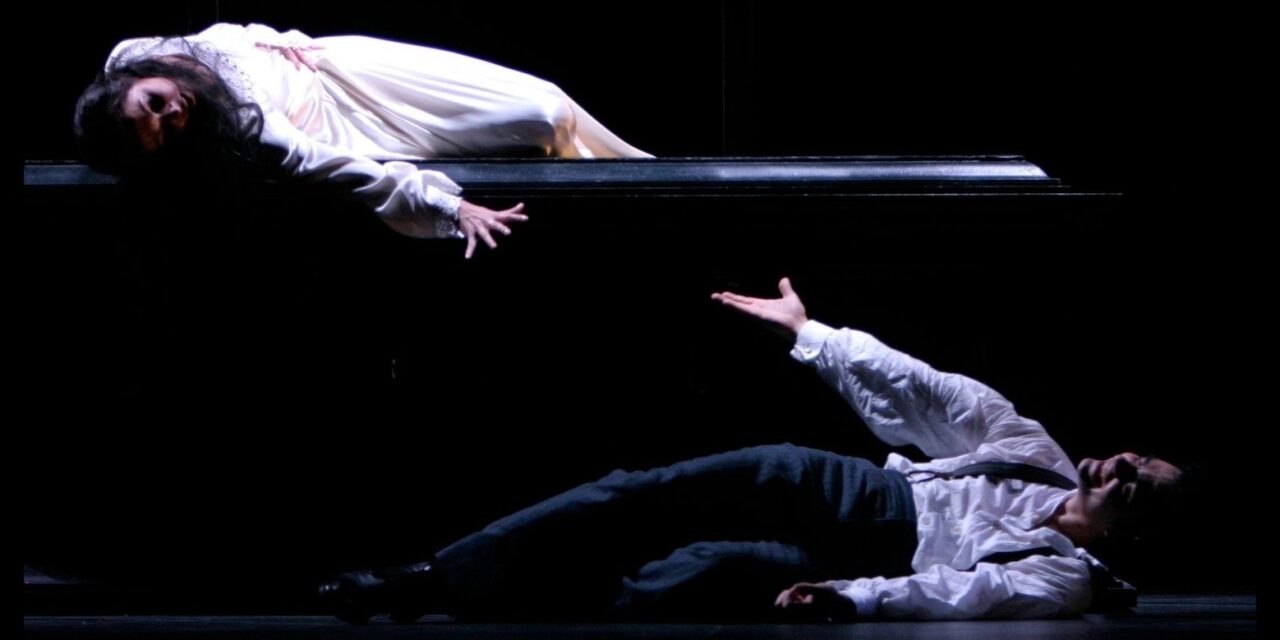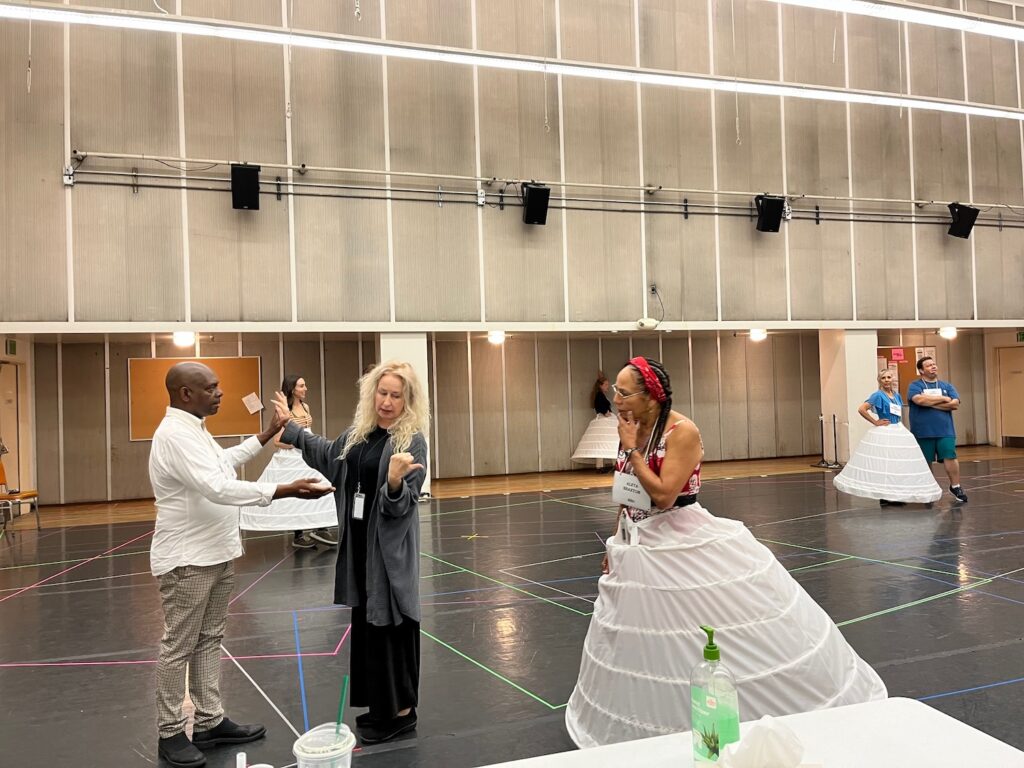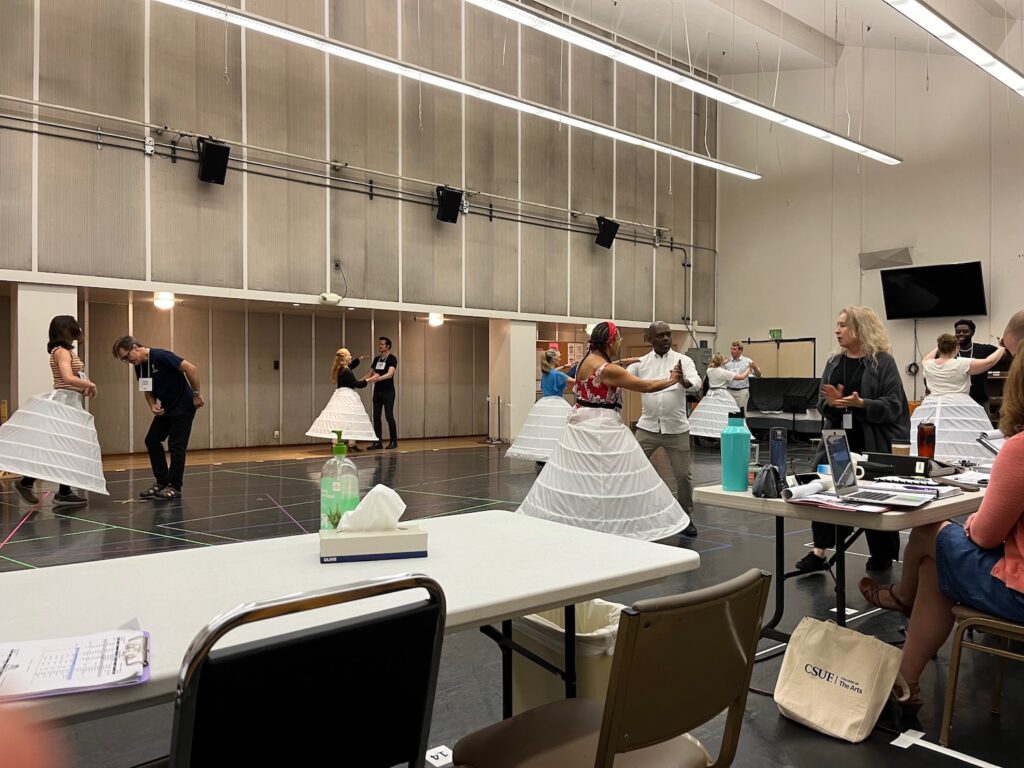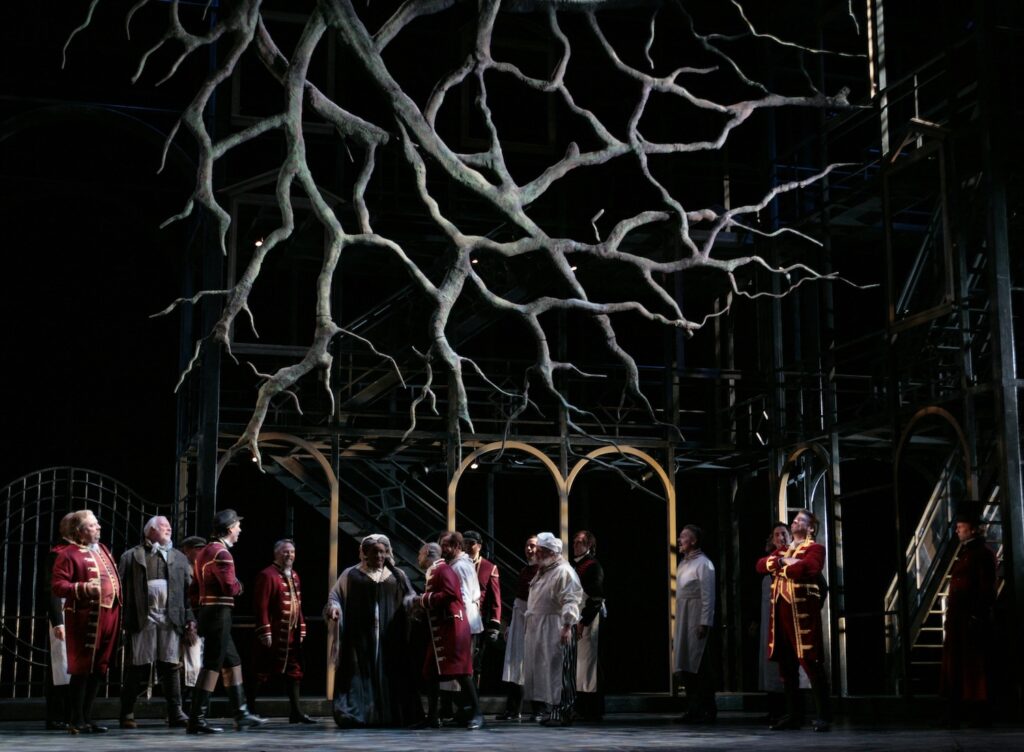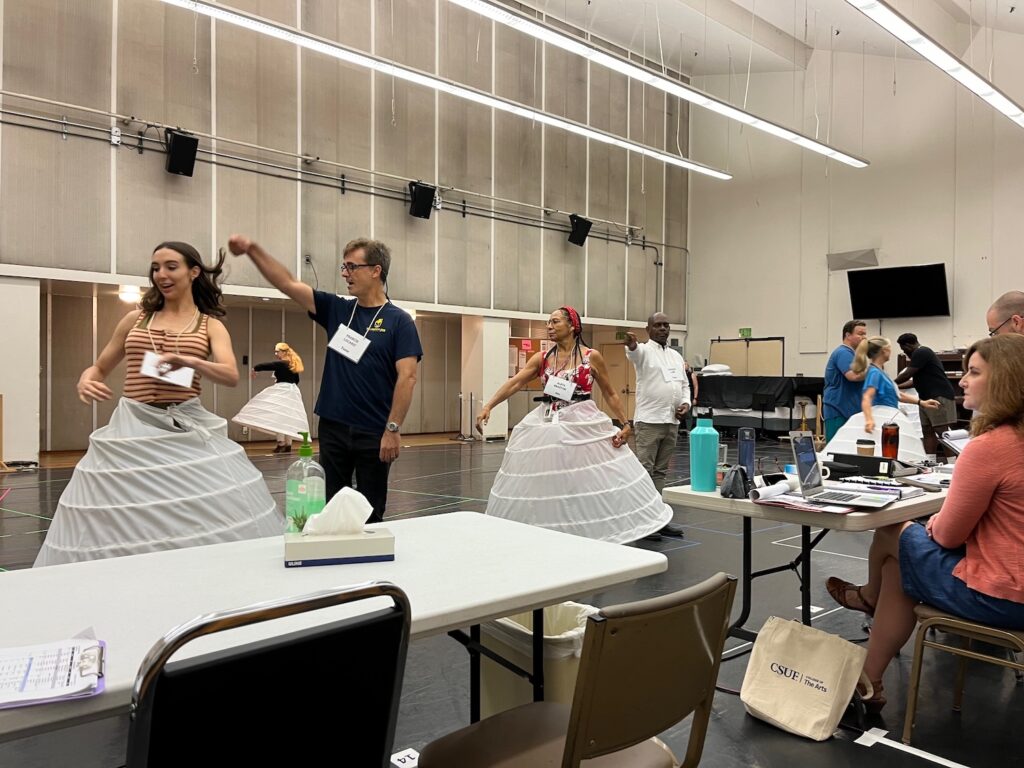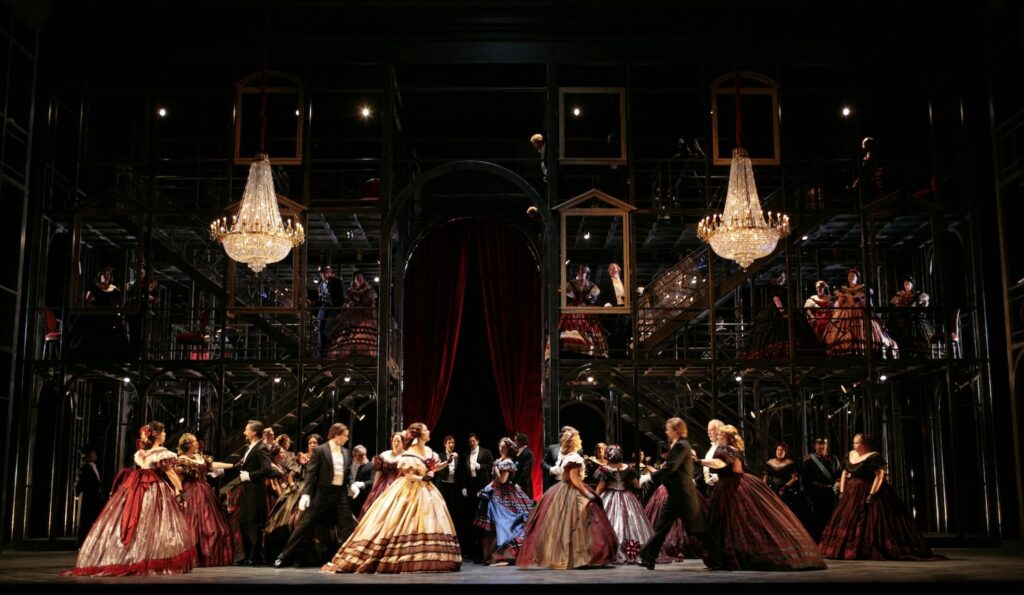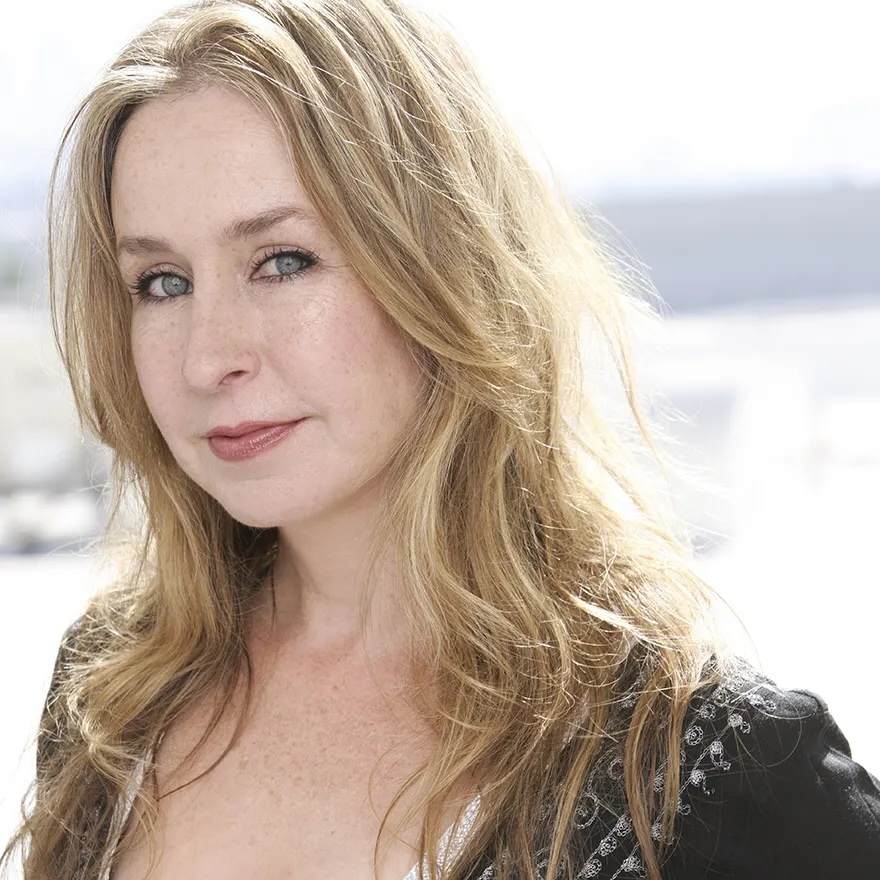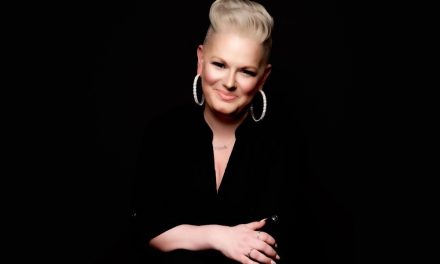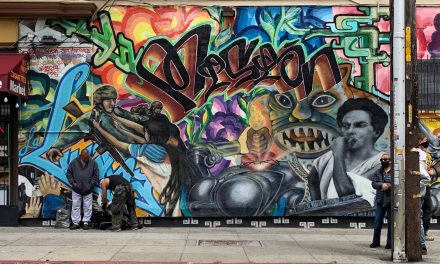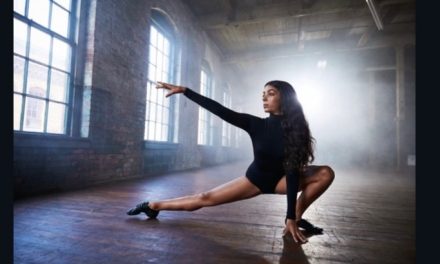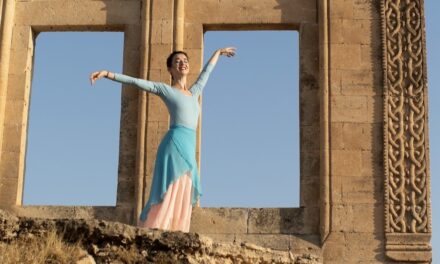The October weather outside the Music Center reads 90 degrees. Inside, a stage-size rehearsal room hosts a dozen men and women of varying types and ages, all dressed for the weather, some in shorts and tank tops. A petite woman begins pairing the group into six couples as costumers assist the women to tie on hoop petticoats that swing with each movement as the six couples line up. These are members of the LA Opera ready to rehearse Charles Gounod’s Romeo and Juliet opening at the Music Center’s Dorothy Chandler Pavilion for six performances from November 2 to 23, 2024. Tickets are on sale now.
The petite woman moving people into line is noted LA choreographer Kitty McNamee who knows LA Opera and especially this opera well. In addition to her contemporary dance company Hysterica, over two decades, McNamee choreographed a dozen LA Opera productions including earlier productions of this Romeo and Juliet. This Romeo and Juliet is very, very different as McNamee makes her debut as the opera’s director as well as choreographer.
Unlike the original Shakespeare play or most dance and ballet versions, Gounod’s prologue doesn’t dwell on the conflict between the Romeo and Juliet’s families. Instead, it establishes the conflict then the action begins at the end, with mourners at the dead lovers tombs, then shifts back in time to the fateful ball where the lovers meet and start on their passionate path to tragedy. The rehearsal is focused on those two scenes.
After the costumer distributes long cloaks, McNamee guides the couples in a procession that rings the two dead lovers. She notes a musical cue when the couples begin to disperse, reforming into a line across the rehearsal space. A row of footmen enter behind the couples. McNamee gives a count to each couple, shows the man how to grasp his partner’s cloak. The accompanist begins playing, the chorus master Jeremy Frank sings the words, then one at a time in canon, the women twirl out of their cloak, with the cloak in her partners hand. Still in canon, as each man hands off his own cloak, the couples begin waltzing in patterns the director mapped out. Almost cinematically, the mourners have transitioned into celebrants at the Capulets’ ball.
Despite the usual learning moments, everyone is picking up the dance sequence and their paths of travel. As the rehearsal continues, the chorus master’s singing permits the couples to concentrate on their dancing and maneuvering the women’s swinging petticoats. After a few run-throughs, the couples have the choreography down, a quick learn because these are not professional dancers, but LA Opera chorus members who will be dancing as well as singing. There are dancers handling sword fighting duties, but in this production, McNamee has all dancing done by the chorus members and the two principals, Duke Kim and Amina Edris, as Romeo and Juliet who are also making their debuts. Another debut is conductor Domingo Hindoyan presiding at the initial four performances, with LA Opera’s resident conductor Lina González-Granados conducting the final two performances.
After the rehearsal, McNamee talked with LADC’s Ann Haskins about the opera and taking on the director’s responsibilities.
Q. This is the third time the opera has done this production of Gounod’s Romeo and Juliet. I understand that you choreographed the original in 2005 and also the 2011 production.
A. That’s right, 2005 was my first time working with the opera, and it was also the first opera I ever choreographed.
Q. Were there things you took away from the experience as choreographer in 2005 and 2011 that you’re using now as director?
A. Absolutely. Ian Judge was the original director. He not only was very deeply experienced, but he was also, in my opinion, a master in the way that he moved the chorus. He had an almost choreographic sensibility about when and how to move these giant groups of people around the stage and create these giant sweeps of action. Because of him, I was able to apply how he thought about movement in an opera to my sensibility and look at opera differently. I learned more about how to move large groups of people. It gave me courage because with my dance company Hysterica and other work I had done some of this, but definitely on a much, much smaller scale.
Q. How has that experience evolved into what you’re doing in this production? As an existing production, it comes with sets and costumes. Is it like a house that has a certain number of rooms, but you have some ability to redecorate or repurpose certain rooms?
A. Yes, I think the set is like the house, it’s very strong, it’s an incredible, multi-faceted set done by John Gunter, who sadly has passed away. It’s almost like a skeleton or framework of buildings that shift. What structure remains when people enter is dictated by the music and the story. How they execute what they do once they come on stage is what I can have some influence on. I’m really, really interested in storytelling, really interested in movement, and I’ve grown even more interested in singers, like those I was just working with. They are a new breed of singers, really open, interested not only in singing, but also storytelling. This is like the perfect opera for singers like that, because they have to use the music and use the staging to move the story forward. There are some established singers who are very open to new ideas, but this group has been amazing to work with.
Q. Both of the leads are making their debuts. Please, tell me about them.
A. Well, Duke Kim who’s doing Romeo, is really physical. I call him my sporty Romeo. I asked him to climb the gate over into Juliet’s garden. No problem. He’s totally game. We got onto the set last night for the first time. I had him climbing up into the balcony and he’s like, “Yes, let’s do it!” He’s really into the challenge of the physicality of the role.
Amina [Edris], who is Juliet, is like a diamond. She understands the role. She speaks French, so as she’s singing the role, it makes absolute sense, and she’s physically very present. It’s an interesting contrast, because she’s very fiery and warm, and he’s more princely, a little bit more cautious. So the combination of the two creates a really dynamic chemistry.
Q. So in your view is it Juliet who moves the two of them forward on this path?
A. I’m so glad you asked, because that is the goal of our production. I’m seeing the story through Juliet’s lens. Even today, women don’t have as much agency as men. We’re still fighting for it still, but in the situation Juliet was living under, it was impossible to have any agency. Taking the risk to move her life forward despite all those constraints is really why she is a heroine. It really should have turned out beautifully if the system around her didn’t clamp down and crush them. During the poison aria, I think that is the moment when she really grapples with the situation and gains agency. It has a tragic end, so it’s a paradox, but her taking action is really what makes the whole thing happen.
Q. The opera handles the timing of their deaths differently from most dance versions where Romeo thinks Juliet is dead, dances with her, kills himself, then she wakes up, and kills herself. In the opera he is dying, but she wakes up, and they have an aria together before he finally dies, and then she chooses to die too.
A. Yes, I think, I think that Gounod and the librettists wanted the opportunity to express a moment, which I’m really glad that they did. It’s one of the most beautiful moments of the opera. It is heroic and tragic and romantic all at the same time. It’s just that moment in the Zeffirelli film version where she wakes up, he’s just died and when she kisses him, his lips are still warm. Even when I think about that, it makes me cry. It is just so close, so close, to shifting the entire narrative of a society, and they don’t make it. It’s so tragic.
Q. At the rehearsal I watched, you were working on the opening where the singers are mourners at the two graves and then transition by the removal of the cloaks into the ballroom scene. You don’t just have the ladies take off their cloaks, you twirl them out of their coats one at a time in canon.
A. Yes, all that is my choreography. The transition into the ball scene is like a whirlwind. The whole stage whirls into this entirely different scene, like we’re going back in time from the graves to a happier time. Some of the chorus danced in the prior production. They know the choreography. I also wanted to have a range of people dancing, younger people to more mature people who would be both mourners and then at the ball.
Q. Are there areas you choreographed for the prior productions that you’ve changed for this one?
A. Yes, some things. I am changing Lord Capulet’s part in the party scene. Craig Colclough had a suggestion that I loved for his version of his character Lord Capulet when he is working his way down the line of all the party guests. He sings, saying: “When I was young, we really had fun. We really danced as much as we could. We danced the night away. Come on, you guys, take advantage of your youth while you can.” In the previous production, I had him dance a bit with each of the six dancing ladies. He would dance with this woman a little bit, then he would go to these two ladies and swirl them around. Craig said, “I would just like to grab one of these ladies and dance the entire width of the stage.” I said, “Yes! Let’s do it!” So I changed that moment.
Q. What is different about being a director, as opposed to a choreographer?
A. It’s a really big difference. I had never directed an opera and I was nervous about it. I’ve directed other things, and with my dance company, I did everything. I am really pleasantly surprised at how comfortable I am with it. Also, here at LA Opera, I have a tremendous amount of support. The whole production team has been incredible in making sure that they are filling in any gaps in my knowledge and showing me how the nuts and bolts of things work. And the music staff has been a joy. To get to work with Lena Gonzalez, who obviously shares my obsession with music, and to learn from her, has been incredible.
Q. I noticed during the rehearsal there were points where you were indicating certain musical cues, and the chorus master Jeremy Frank would verbalize or sing the lyrics for that musical point. It was an interesting bi-lingual combination of, musical cues and cues in the lyrics that seemed to be a very comfortable and seamless back and forth between you and the chorus master.
A. This process is super collaborative and helpful, because dancers think about music in one way. Many count it out while others, like me, don’t count but go on the phrasing of the music. However, for the singers translating the movement into the lyrics helps them tie the movement with what they will be singing. The challenge is to find how to communicate across format. In a situation where needs are different, you have to figure out how to communicate. A director has to be able to speak to the chorus and soloists, as well as speak to dancers. I’ve found if I’m doing both, I have to switch my brain yet be able to be clear and supportive of people’s ways of working.
Q. I recognized your assistant Catherine Cowgill from Los Angeles Ballet and as a dancer in some other operas that you choreographed. What is her role?.
A. Because I’m directing and choreographing, it’s a lot of responsibility and also a lot of time. As my assistant for this production, Catherine and I are able to move quickly sort of divide and conquer. I can give notes or corrections to Catherine, and then she can execute them with the cast. Particularly, now that we have moved on the stage, I can give her notes during rehearsal, and I can be working on the technical side of things, say on lighting, while Catherine goes down and transmits those notes to the chorus. Also, she’s another set of knowledgeable eyes. She was ballet master for LA ballet, deeply experienced at setting works, and very detail oriented.
Q. It is always significant when someone known as a choreographer moves into the director’s chair. Any advice or thoughts about what your move to director of this opera production means?
A. I guess my advice would be, if you’re choreographing and particularly if you are leading a dance company, realize that you are already directing. What I love to choreograph is long form dance works, essentially, storytelling, just no text or singing. But in creating these long form works, I was directing. Recognize that the skills you have are really the skills that you need to move into directing. Don’t be afraid. And personally, for me, I feel really grateful that LA opera took the lead to give me this opportunity. It’s a huge opportunity, and I’m so grateful. That’s why I’ve wanted to recognize the amount of support and collaboration I’m getting in this experience.
Charles Gounod’s Romeo and Juliet at Music Center Dorothy Chandler Pavilion, 135 N. Grand Ave., downtown; Sat., Nov. 2 & 23, 7:30 pm, Sun., Nov. 10 & 17, 2 pm, Thurs. Nov. 14 & Wed., Nov. 20, 7:30 pm, $33.50-$400. https://www.laopera.org/performances/2025/romeo-et-juliette
For bonus peek at the rehearsal this Instagram video is courtesy of Marlene Meraz at LA Opera: https://www.instagram.com/p/DBKl_IQyxgR/
For more information about the LA Opera, please visit their website.
For more information about the Music Center’s Dorothy Chandler Pavilion, please visit their website.
Written by Ann Haskins for LA Dance Chronicle.
Featured image: LA Opera’s Romeo and Juliet – Photo by Robert Millard.

